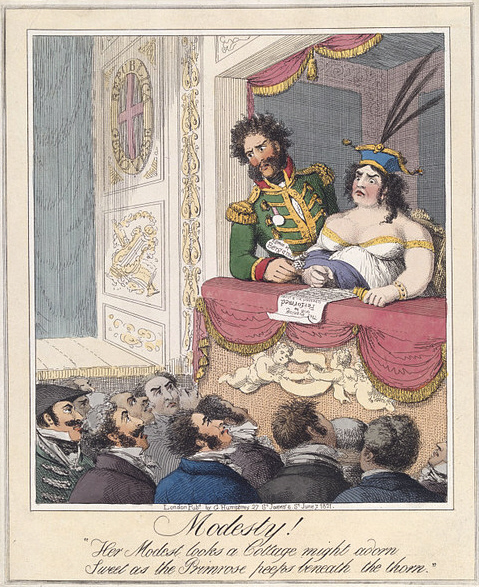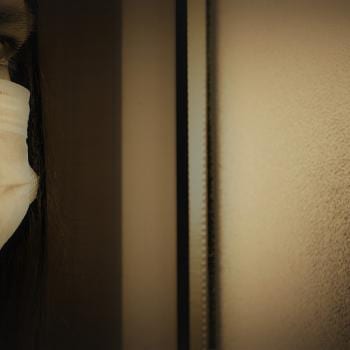My friend Iris* is fifty years old, beautiful and brilliant, with silver hair that I envy, and a casual bohemian style. She teaches a catechism class in the town where I work, and I am trying to figure out how to get my son into her classes, because I am pretty picky about who provides my children with religious education, and Iris is one of few I trust.
A few weeks ago, Iris was teaching on the Liturgy of Light to her usual class for 6-9 year olds, as well as a visiting group of 10-12 year olds. A significant percentage of her class is made up of homeschoolers like ourselves; the rest are public school children. After the class was over and the students had left, she found that someone had left a note for her:
“Your presentations are great – thank you! your low cut apparel is distracting”
Allow me to point out that Iris does not wear low cut apparel, at least not as I understand it. In many Catholic homeschool groups you’ll find the occasional woman who delights in flouting the stereotypical regulations of the self-appointed modesty police, but Iris is not that type. She just dresses comfortably.
But even if she did actually wear low cut apparel, there is something seriously wrong with an ideology that would encourage a child to send such a note to a catechism teacher. Or, for that matter, to anyone. The note is disrespectful, immodest, and offensive. One can speculate about whether it was sent by a boy or a girl, or what age the sender was. One can speculate about whether the child opted to write the note independently, or was prompted to do so by a parent – and, honestly, I am not sure which option disturbs me more. A child between the age of six and nine is not likely to be distracted by a non-turtleneck unless he or she were already trained to do so. And any adequate education in manners should teach children that it is rude to send notes to people with critical commentaries on their appearance, and education in morality means taking responsibility for one’s own feelings of discomfort or distraction, not blaming them on another.
Curiosity about bodies not one’s own is a normal and healthy aspect of human development, and I always answer my children’s questions by giving matter of fact explanations of how bodies work, and the different possible functions for different parts. I also use these questions as an opportunity to remind them that a person’s body is his or her own, that it is rude to comment on people’s bodies, and that we should never touch the bodies of others without their consent, that every body is unique and deserving of respect because a human body is never just a body. A human body is a human person. I remind them that some people might not be happy in their bodies, so it is especially important never to offer unseemly commentary that might add to their distress (“fat” is a food, not a descriptor of persons).
I can’t imagine any of my children ever being distracted by low cut apparel unless the person were exposing some kind of crazy dinosaur tattoo on her decolletage. This is not because of my amazing parenting, or my children’s amazing powers of concentration, but because they have seen me and other moms nursing babies often enough. On such occasions, the baby is usually more interesting to them than the objects on which the babies suckle.
Recently I addressed the problem of stressing “custody of the eyes” as a protection against sexual sin (“custody of the eyes, and the danger of nihilistic despair”) – and this is a perfect instance of how damaging this approach to modesty is. With all the complaints that are made – justifiably- about the hyper-sexualization of the female body by secular media, we need to consider the harmful way in which the elevation of this false idea of modesty hyper-sexualizes women, and teaches children to regard bodies as objects instead of persons. If we take seriously the idea that lust is a sin, we should be thinking about how to mitigate it, how to reduce the instances in which it is likely to occur, and teaching our children to regard basic elements of female anatomy as dangerous sexual weapons that need to be concealed is not going to help in this regard.
I feel bad for children who are brought up to be so fearful of seeing even a clothed female body; it will be very difficult for them to maneuver in a pluralistic culture, or to take any job in which seeing a person’s body is part of the ordinary business. I can not blame the child who sent the note to my friend, but I can certainly blame the moral education and cultural milieu that would train a child to consider such behavior acceptable.
Modesty is a virtue, and to be found in human action, not in human clothing. We need to teach our children to behave with modesty. Making indecent commentaries on a woman’s appearance is not modest.
*Name has been changed
Image credits
1) Modesty!, etching, published by G. Humphrey , London, 7th June 1821, (Caroline of Brunswick, wife of King George IV, at a theatre in Genoa, with her secretary and constant companion Bartolomeo Pergami). Public domain in the US (PD_US)> Victoria and Albert Museum, London, Museum number: S.51-2008https://commons.wikimedia.org/wiki/File:Modesty_1821.jpg
2) From the author’s photo collection













